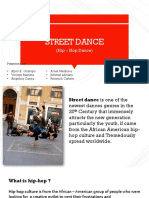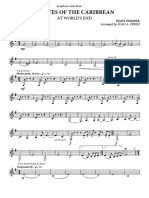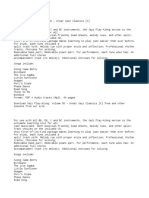Retro
Uploaded by
joanna faith repizoRetro
Uploaded by
joanna faith repizoRO
Prepared by:
1
HISTORICAL DEVELO
PMENT OF
LINE DANCE
× RETRO DANCE - covers a broad range of blues
based styles developed during the 1930s to 1950s. These
dance styles share similar patterns of movement,
composition, and core dance content but vary with
respect to their characterization, emphasis and structure
to provide clearly related but distinct dance
2
HISTORICAL DEVELO
PMENT OF
LINE DANCE
× Retro music was become popular because of the large
dancing movement all around the world. It was
popularized in the late 1960s as an alternative music
styles preferred by the youth. The Funk, hip hop and soul
are the famous types of dance flourished in the North
America. During the mid-1970s to early 1980s, Retro
Pop Dance reached its peak as a form of entertainment of
the youngsters of their various backgrounds.
3
HISTORICAL DEVELO
PMENT OF
LINE DANCE
× The origin of the Retro Pop Dance can be traced and
identified through the formation of the night clubs –
discotheques where Nazi occupied Paris. The radio
presenters is usually called as disc jockey or commonly
known as DJ wherein they played Jazz records and the
like.
4
HISTORICAL DEVELO
PMENT OF
LINE DANCE
× To name the few musical hits of disco
performers such as Donna Summer, Boney
M, Bee Gees, The Tramps, Chic and Gloria
Gaynor which inspired by the Hollywood
films (Saturday Night and Thanks God It’s
Friday.
5
HISTORICAL DEVELO
PMENT OF
LINE DANCE
× In the Philippine setting, retro pop music or disco songs
are as follows: Bongga Ka ‘Day, Annie Batungbakal,
Manila, Pers Lab, Langit Na Naman, Dying To Tell You,
Bitin Sa Iyo, and Beh, Buti Nga was popularized by the
The Hotdog band. After the decline of disco music,
practitioners used this dance for the fitness exercises.
6
Etiquette in Dance
7
Every dance class that a student will
attend have their own rules or policies to
follow. These rules are ways to make the
dance session more productive and
successful.
8
Here are some etiquette to follow:
1. Always pay attention to your dance instructor. It is
essential to listen to every detail in order to familiarize
with the lessons easily.
2. Wearing the appropriate dance attire. It should be
observed from time to time in order to avoid
destruction while attending the classes.
9
Here are some etiquette to follow:
1. Attending classes on time. It is more on
professionalism aspect that every student should
possess at all times. The students should be in the
class on or before the session will begin. For this
reason, they can have an ample time to prepare
their needs during the classes.
10
Here are some etiquette to follow:
4. Respect one another. It is a common virtue
that students should follow whenever they are
in the class.
5. Always aim for the BEST. Keep on
moving and practicing until you make it
perfect.
11
RETRO POP DANCE
The Running Man - MC Hammer, was the proponent of
this famous dance step. It is widely performed in different
videos and in disco houses.
The Thriller - This dance step was popularized by Michael
Jackson during the 80’s. It is considered as classic dance
move because it is still incorporating to other dance craze
up to this generation.
12
RETRO POP DANCE
The Sprinkler - This dance step is just like imitating the
garden sprinkler. You just have to assume that you are
watering irrigation or a garden.
The Roger Rabbit - This dance imitates the floppy
movements of the lead cartoon character as seen in the
1988 film Who Framed Roger Rabbit.
13
HIPHOP
14
HIPHOP
– refers to street dance styles primarily performed to
hip-hop music or that have evolved as part of hip-hop
culture. It includes a wide range of styles primarily
breaking which was created in the 1970s and made
popular by dances crews in the United States.
15
HISTORICAL DEVELOPMENT OF THE
HIP-HOP
Hip-hop, cultural movement that attained widespread
popularity in the 1980s and ’90s; also, the backing
music for rap, the musical style incorporating
rhythmic and/or rhyming speech that became the
movement’s most lasting and influential art form.
16
Origins and The Old School
Although widely considered a synonym for rap music, the
term hip-hop refers to a complex culture comprising four
elements:
1. Deejaying, or turntumbling
2. Rapping also known as “MCing” or “rhyming
3. Graffiti painting, also known as “graf” or “writing
17
4. B-boying
which encompasses hip-hop dance, style, and attitude,
along with the sort of virile body language that
philosopher Cornel West described as “postural semantics.
5. “Knowledge of self/consciousness,” is sometimes added
to the list of hip-hop elements, particularly by socially
conscious hip-hop artists and scholars.)
18
New School
In the mid-1980s the next wave of rappers, the new school,
came to prominence
A. Run-D.M.C., a trio of middle-class African Americans
who fused rap with hard rock, defined a new style of hip
dress.
19
2. Def Jam featured three important innovators:
a. LL Cool J, rap’s first romantic superstar;
b. the Beastie Boys, a white trio who broadened rap’s
audience and popularized digital sampling (composing
with music and sounds electronically extracted from
other recordings);
c. Public Enemy, who invested rap with radical black
political ideology, building on the social
consciousness of
Grandmaster Flash and the Furious Five’s “The
Message” (1982).
20
In the 21st century the music—born from the
sonic creations of the deejay—saw its greatest
innovations in the work of such studio
wizards as Timbaland, Swizz Beatz, and the
Neptunes. Still, major stars continued to
emerge.
21
You might also like
- Fairytale of New York Winterville - Full Score100% (1)Fairytale of New York Winterville - Full Score20 pages
- Popular Dance: Isaac. Alexandra Nicole Q BSA-1CNo ratings yetPopular Dance: Isaac. Alexandra Nicole Q BSA-1C5 pages
- Lesson #1: Introduction and Historical Background of Hip-Hop DanceNo ratings yetLesson #1: Introduction and Historical Background of Hip-Hop Dance16 pages
- 2nd Quarter Periodical Exam Pointers To Review in Pe 3No ratings yet2nd Quarter Periodical Exam Pointers To Review in Pe 39 pages
- Jene Rose Pagayon BSACTY-2 Stubcode: 1051 What Is Dance? Dance Is A Performing Art. It Is Described in Many Ways. It Is WhenNo ratings yetJene Rose Pagayon BSACTY-2 Stubcode: 1051 What Is Dance? Dance Is A Performing Art. It Is Described in Many Ways. It Is When3 pages
- Blue and Gray Minimalist Business Coach Marketing PresentationNo ratings yetBlue and Gray Minimalist Business Coach Marketing Presentation11 pages
- 2nd QUARTER REVIEWER HOPE 3 SY 2023 2024 FinalNo ratings yet2nd QUARTER REVIEWER HOPE 3 SY 2023 2024 Final3 pages
- Dance History: Prepared By: Ferry Ann Montes100% (1)Dance History: Prepared By: Ferry Ann Montes28 pages
- Afro-Brazilian Culture in London - Simone FrangellaNo ratings yetAfro-Brazilian Culture in London - Simone Frangella17 pages
- Maria’s Records Artist Development ProgramNo ratings yetMaria’s Records Artist Development Program4 pages
- Vivaldi - Michael Talbot, Second edition, 1993, Part 9No ratings yetVivaldi - Michael Talbot, Second edition, 1993, Part 978 pages
- The Cambridge Companion to the Musical Cambridge Companions to Music Second Edition William A. Everett - The latest ebook version is now available for instant access100% (1)The Cambridge Companion to the Musical Cambridge Companions to Music Second Edition William A. Everett - The latest ebook version is now available for instant access47 pages
- Piratas Del Caribe - El Fin Del Mundo - SplitNo ratings yetPiratas Del Caribe - El Fin Del Mundo - Split2 pages
- Bendian Dance: Instruction: Write A If The Statement Is True, B If Otherwise. Put Your Answers On A Clean Sheet of100% (1)Bendian Dance: Instruction: Write A If The Statement Is True, B If Otherwise. Put Your Answers On A Clean Sheet of27 pages
- West Gallery Music Francis Roads: A Benslow Music CourseNo ratings yetWest Gallery Music Francis Roads: A Benslow Music Course4 pages
- Centro Escolar University School of Education, Liberal Arts, Music and Social WorkNo ratings yetCentro Escolar University School of Education, Liberal Arts, Music and Social Work3 pages
- Designing_Tube_Preamps_For_Guitar_and_Bass super 300str optim_Part4No ratings yetDesigning_Tube_Preamps_For_Guitar_and_Bass super 300str optim_Part450 pages
- 12 2 Jazz Play-Along Volume 50 - Great Jazz Classics (X)No ratings yet12 2 Jazz Play-Along Volume 50 - Great Jazz Classics (X)8 pages

























































































